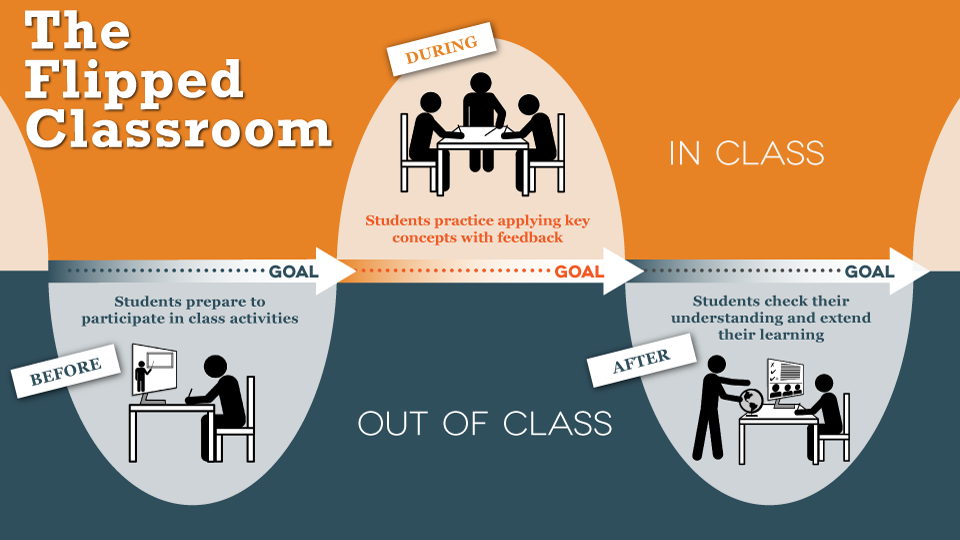Flipped classroom. What does is it exactly mean? It's a 180 degree shift in 'traditional' education. But what does that say? In the traditional model the teacher stands between the students and the knowledge. With the flipped classroom, students have direct access to the knowledge and the teacher serves as a coach and mentor. With the flipped classroom model, students have to prepare their contact moments. During contact moments teachers are able to zoom in on the application and deeper processing of the learning material.
Why flip the classroom?
Interaction is a key element when flipping the classroom. Students
have prepared their homework and already have basic knowledge about the
subject. During class time, it's possible to dive deeper into the
learning material and ask questions. As a teacher you get to know what
kind of difficulties students are dealing with and where to focus on.
Furthermore, the teacher can offer more challenges for students who
easily cope with the learning material. The other way around, the
teacher is able to offer other students more help when needed.
How to flip the classroom?
The main thing is that students have to play an active role in preparing their homework. If they don't, they get easily distracted. It's like driving a car without knowing the rules, conclusion: a disaster. You have to motivate your students to prepare their homework. The homework teachers give their students has to be clear, it's has to be understandable for everybody! The teacher can create a video of themselves in which they explain a certain subject. Share this with the students. At last, teachers are able to help students according to their needs. In short terms, more efficient and effective completion of the contact time.
Flipped Classroom Advantages And Disadvantages
The flipped classroom has some pros and cons. Do the advantages outweigh the disadvantages? The flipped classroom is a method that is becoming more popular since the advent of internet. It's a 180 degree shift in traditional education. With the flipped classroom, students have direct access to the knowledge and the teacher serves as a coach and mentor. What are the advantages and disadvantages of the flipped classroom? Will the advantages outweigh the disadvantages? You will find out in this article :-)
Flipped classroom advantages
Self-paced learning
When students prepare their class, they can work whenever they want and take whatever time it takes to finish (as long as it's before the deadline).
Dive deeper into subject
When students have a basic knowledge about a certain subject, you can dive deeper into the learning material. You can offer more learning material to students who are looking for a challenge.
Better prepared (you know the results and statistics)
Students can follow courses where teachers put on homework students have to prepare. Teachers are able to track the progress of students and view their results. This makes it possible to have a clear idea of what the struggles are of your students and see what students struggle the most. Furthermore, it allows teacher to identify errors in thinking or concept application.
Lectures can be reused
It can take a lot of time to prepare homework for students. But once you got it all, it's easy to re-use your lectures for next year.
Flipped classroom disadvantages
Technology issues
No access to internet means no homework. Once students don't make their homework, they get easily distracted by other things. And you don't want that to happen. Nowadays, there are a lot less technology options. So, this issue will become less and less relevant.
Organization
The first time you implement the flipped classroom, it will have to be a lot of organization. Teachers have to introduce the students to the whole different concept. This can take some time, because they go from a more passive learning style to an active learning style.ÃÂÃÂÃÂÃÂ
Lack of motivation
You always have to be motivated to do your homework and be prepared for class. If you don't, you'd be easily distracted by other things. When you don't have the basic knowledge, it's hard dive deeper into a subject. Teachers should really motivate students to do their homework, otherwise there's no flipped classroom.
Not for every student
'Meta cognitive skills'Â seems like a difficult word, but is easy to
explain. It's about knowing how to learn and on what learning style
suits you best. The flipped classroom requires a lot of self-discipline.
Students have to know how to learn, this will come with time.
Conclusion
Will the advantages outweigh the disadvantages? Yes. Well, at least with one footnote. Students have to be capable of being motivated to do a lot of work at home. This method won't work at elementary school. It's a good method to use for applied university or university. The flipped classroom seems to be a great way to dive deeper into the learning material and help students where needed.
